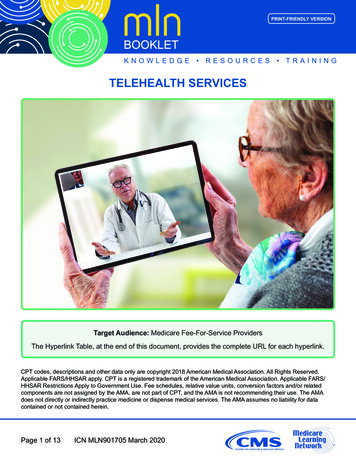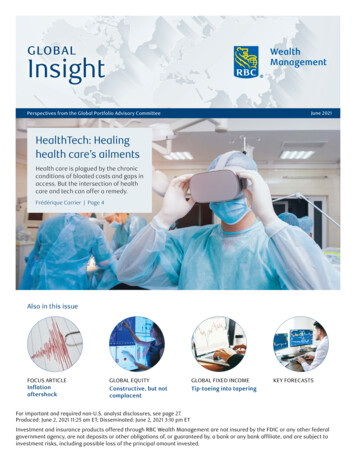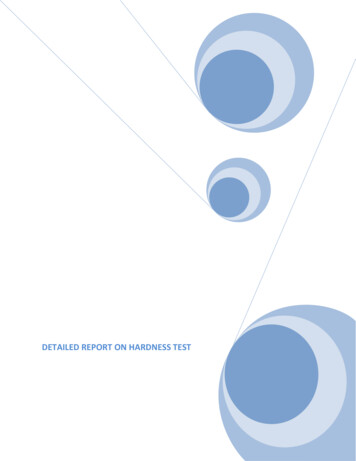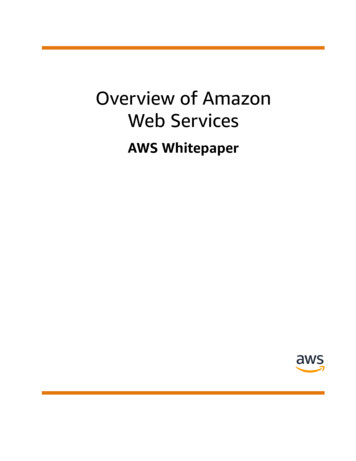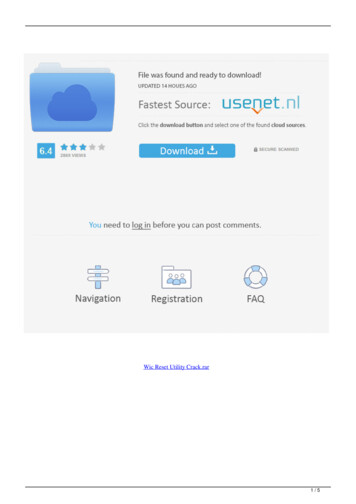
Transcription
The techUKTen PointPlan forHealthtech
2
The techUK Ten Point Plan for er 1Empowering the publicChapter 2Embedding standards and interoperabilityChapter 3Digitising social careChapter 4Supporting the health and social care workforceChapter 508172734Reforming business environment and procurement42Afterword49References503
The techUK Ten Point Plan for HealthtechForeword“During our response to this pandemic, we have had aweapon in our armoury that previous generations simplydid not possess – the incredible emerging technologiesthat have spurred so much innovation in healthcare.”The Rt Hon Matt Hancock MPSecretary of State for Health and Social Care¹There’s no denying that 2020 was a year of change. A year that we could nothave gotten through without the efforts of key workers across the country, and,crucially, without our health service and the millions of administrative staff,nurses, doctors, care workers and many others that are working around theclock to keep us safe.For techUK and its members, including thehundreds of companies of all sizes operating inthe health care technology space, 2020 wasalso a year where we saw significant changein the health system’s approach to adoptingtechnology and innovation.To build on this momentum, our Health andSocial Care team has drafted a list of 10recommendations, informed by our regularengagement with our members, our Health andSocial Care Council, our strategic partnershipwith NHS Digital, our work with NHSX, theProfessional Record Standards Body (PRSB),Health Education England, the NHS DigitalAcademy, INTEROPen, the Shuri Network, andmore, brought together in what we call the techUKTen Point Plan for Healthtech.This paper is not meant to be an exhaustivereview of the health care technology landscape,but rather to provide a breakdown of what ourmembers see as the biggest challenges in thespace and a set of recommendations for how wecan drive progress. In order to achieve our statedobjectives, techUK welcomes further dialogueand collaboration with the service.We would like to thank everyone whocontributed to the process.4
RecommendationsOur commitment:techUK will work with members and stakeholders across the digital health andcare ecosystem to support efforts to deliver on these recommendations. Weare committed to playing our role in representing industry and helping to builda world-class digital health and care service that empowers patients, staff, andcitizens, fostering true innovation.1. Putting the power into the hands of the publicThe health service should prioritise improving citizens’ access to their own data, enabling them tomake data-driven, informed decisions about their own care.2. Developing world-class digital health and care standardsNHSX should continue to work with industry to ensure the Digital Technology Assessment Criteria(DTAC) is fit for purpose; raise awareness and support commissioners to understand and utilisethe DTAC; work with third-party assessors to maintain a pipeline of innovation; and engage withthe relevant stakeholders to realise a functional reimbursement model for citizen-facing digitalhealth technology.5
The techUK Ten Point Plan for Healthtech3. Communicating the value of digitalThe NHS should leverage the channels that the public uses to access information about healthand care to raise visibility of citizen-facing digital health technology. Stakeholders shouldconsult on creating a mechanism that allows individuals to easily access information about theinnovations available through the service within a specific locality, and commissioners to checkwhat is being done across the country.4. Applying an international, open standards first approachtechUK encourages NHS Digital and NHSX to take an international, open standards first approachas it develops national assets and infrastructure. Further education of NHS staff about whatinteroperability means in practice will help to reinforce the importance of this approach.5. Centrally mandating, assessing and enforcing the use of interoperabilitystandardsThe Department of Health and Social Care should centrally mandate, assess and enforce theuse of interoperability standards through NHSX and NHS Digital. Standards should be locallyimplemented and co-developed with both industry and the service itself. These should thenbe collated into a single, searchable interoperability standards registry. This standards registryshould be transparent and accessible by end users so they understand what they should adhereto.6. Supporting integration of social care through digital transformationThe Department of Health and Social Care, the Ministry for Housing, Communities andLocal Government, NHSX, and local authorities should work with techUK and other industryassociations to establish a commission to audit the structure and digital maturity of the socialcare landscape. This audit will help industry better support the digital transformation andintegration of the health and care system. Having completed the audit, they should define a“target architecture” for care that will help to establish a roadmap for providers to identify whattechnology they need to implement.6
The techUK Ten Point Plan for Healthtech7. Increasing digital maturity of staffStakeholders should leverage industry partnerships in the digital upskilling of staff, with a focuson continuing to improve boards’ understanding and confidence of digital; designing clear careerpathways for informatics staff; and developing a diverse and inclusive informatics workforce.8. Providing targeted and dedicated investment for digital technologyFollowing on from the findings of the recent Public Accounts Committee and National AuditOffice reports, techUK believes that the vision for a digitally mature system should be deliveredthrough targeted and dedicated investment in technology for health and social care. This fundingshould be ringfenced and delivered via multi-year budgets that will allow flexibility betweenCapital (CapEx) and Revenue (OpEx) where appropriate.9. Enshrining the role of the Integrated Care System into lawIn line with the Long Term Plan’s recommendation to establish Integrated Care Systems (ICSs)nationally by April 2021, techUK calls on the Secretary of State for Health and Social Care toimplement plans to establish the role of the ICS in law. This will help to simplify and codify theprovider landscape, making it easier for suppliers to engage with the health and care system.10. Streamlining procurement of digital technologyAs part of a comprehensive plan to reform procurement, the health and care sector should pivottowards outcomes as the primary success factor for digital transformation; signpost suppliersto existing frameworks; provide an accurate estimate for their total value; offer specialist trainingfor procurement staff who are buying technology; and prioritise the streamlining of existing andfuture frameworks by committing to reducing their proliferation.7
Chapter 1Empowering thepublic“We will empower citizens to participate in theirhealth and care by ensuring there are digital toolsand services available for them to accessinformation and services directly. We will enablethe health and care system to personalise people’sexperience to meet their needs, improve healthoutcomes through timely interventions, and byenabling more effective interactions across caresettings.”NHSX Tech Plan - Vision²9
The techUK Ten Point Plan for HealthtechBackgroundOver the past 72 years, the NHS has delivered massive achievements.³ Life expectancy has increasedby 13 years4, despite slowing in the past decade. However, more than 20% of an individual’s lifeis estimated to be spent in poor health5, and millions of people live with one or more long-termconditions.6Coupled with the increasing pressures posed by an ageing population, the health and care systemhas been grappling with years of financial strain7 and staffing shortages.8 With COVID-19, thesechallenges are now becoming even more severe.To future-proof the service in the run-up to its 80th birthday and beyond, as outlined in the NHS LongTerm Plan, the need for transformation is clear. Citizens have to be given access to the data and toolsneeded to lead longer, healthier lives.The Government recognises the role of digital technology in putting the power into the hands of itscitizens. At techUK, we believe that only by doubling down on the digital agenda will we be able tobuild on the strengths of our NHS and become a world leader in health care technology, with a modernsystem and a truly empowered public.Opportunity“In the 2020s, people will not be passive recipients of care. They will be cocreators of their own health,” Advancing our health: Prevention in the 2020s9According to the Institute for Health Metrics and Evaluation, over a third of all deaths in the UK canbe attributed to behavioural risk factors.10 Figures from the Office for National Statistics (ONS) showthat prevention makes up about 5% of all public funding on health¹1, meaning over 100bn is spenttreating disease and 8bn preventing it.¹² Meanwhile, long-term conditions are said to account for70% of the health service’s budget.¹³The growing emergence of connected devices such as smart inhalers or wearable heart rate monitorsopens up new possibilities for prevention, treatment and disease management. They can providecost-effective methods to ease pressure on services, enabling the public to take control of their healthand wellbeing and supporting the move from a reactive to a proactive system.At the same time, an increasing number of apps are helping citizens connect with their clinicians,schedule appointments and monitor conditions by integrating with smart devices. Back in 2017, areport by research2guidance¹4 found that there were over 325,000 health apps available on app storesat the time.In recent years, we have witnessed the growth of a new digital health subset called digitaltherapeutics (DTx), which use digital technology to provide therapies and prevent, manage or treat acondition.¹5 There is emerging evidence that the use of DTx is cost-effective in the real world, reducingprimary care resources and spend whilst introducing well evidenced, clinically effective behaviouralchange at scale.10
The techUK Ten Point Plan for HealthtechCase study: Creating capacitythrough ‘telehealth in a box’ duringCOVID-19Docobo, British provider of digital health and telehealth solutions, has beenworking with healthcare organisations in Liverpool to deliver remote monitoringsince 2017. Prior to the COVID-19 pandemic, around 1,800 citizens with chronicobstructive pulmonary disease (COPD), diabetes and other long-term conditionswere cared for using their services.As COVID-19 was declared a pandemic by the World Health Organisation,Liverpool Clinical Commissioning Group requested an expansion of the projectto support its vulnerable population, which it needed to shield.In six weeks, Docobo doubled user numbers to 4,000; and the number laterrose to 5,000. They created ‘telehealth in a box’ to help citizens start using theirservices, and delivered vital equipment including blood pressure monitors andpulse oximeters working with British Gas volunteers. Latterly in the secondwave, patients have been monitored via Covid Oximetry @ Home to preventsilent hypoxia and hospital patients discharged to be monitored at home in aCOVID-19 Virtual Ward under the care of consultants.With a nurse-to-patient ratio of over 1:400, Docobo is supporting Mersey Careto create capacity, helping to improve outcomes and reduce the workload ofoverburdened clinicians during the COVID-19 pandemic.11
The techUK Ten Point Plan for HealthtechCase study: Bringing digital therapyto patients at scaleBritish company Big Health, provider of two solutions tackling insomnia andanxiety, is leading the way in the digital therapeutics space. The company’sproducts are supported by 12 Randomised Controlled Trials and over 50 peerreviewed papers, real-world outcomes and independent health economicsanalyses.In October 2018, the company partnered with the Oxford Academic HealthScience Network to provide digital Cognitive Behavioural Therapy (CBT) at scalein the Thames Valley region to patients living with insomnia, for which NationalInstitute for Health and Care Excellence (NICE) recommends CBT as first-linetreatment. In the past two years, 7,500 people accessed treatment throughthe company’s Sleepio solution, showing a recovery rate of 58% and reportingimprovements in their overall mental health and wellbeing.Studying Sleepio’s¹6 impact on costs in primary care across nine practices over15 months, the Office of Health Economics estimated its use would result incost savings of 4m in three years when deployed across the Buckinghamshire,Oxfordshire and Berkshire West Integrated Care System.1712
The techUK Ten Point Plan for HealthtechBarriersAlthough the digital health and care space is growing, our members have told us that a number ofbarriers continue to stymie widespread adoption and to slow the creation of a vibrant ecosystem ofcitizen-facing digital health and care innovation, including: Lack of access to full health and care records: Despite progress in making it easierfor citizens to view summary care records, accessing records from secondary care and socialcare, as well as integrating valuable data from connected devices, remains difficult.¹8 Lack of clarity regarding the minimum evidence threshold that innovationsneed to meet: From our engagement with members in this space, we hear that innovators arebeing asked to provide varying levels of evidence of effectiveness by buyers. It is not clear whatis the minimum amount of evidence required to show that an innovation has high potential andtherefore should be adopted within the system. No clear route to market or reimbursement pathway: The fragmented approachto evaluation is reflected in a lack of clarity regarding routes to market. Even for innovators withstrong evidence showing their digital technologies can improve health outcomes and deliver costsavings, it is not clear what is the definitive step towards getting reimbursed. Lack of awareness, training and professional development: Members andstakeholders tell us that more needs to be done to ensure that citizens can and know how toaccess trusted information about the growing number of tools they can use to care for theirhealth; and to provide education for clinicians, commissioners and policymakers about digitalhealth and care technology and its different types and use cases, helping to enable betteradoption. In the autumn of 2020, a survey carried out by Diabetes UK found that, according to 40%of the respondents, the greatest difference in improving access to diabetes technology wouldresult from health professionals having the experience and confidence needed to support peoplewith the condition to use it.¹9 The issue of competition versus collaboration: As emphasised in the techUKManifesto for Matt from 2018, the digital health and care industry needs greater clarity withregards to what is planned to be built within the system and what the system believes themarket should provide. Driving transparency, this would help to reduce duplication of effort andencourage the development of the UK’s digital health and care industry.13
Recommendations Citizen-facingdigital health technologyPutting the power into the hands ofthe public“The patient is an underestimated force in the inherentlyconservative healthcare systems all over the world. Empoweringpatients helps to speed up the innovation process,”Erik Gerritsen, Secretary General at the Dutch Ministry ofHealth, Welfare and Sport²0To truly empower citizens and enable them to become ‘cocreators of their own health’, techUK calls on the health and caresystem to prioritise improving the public’s access to their owndata.At the moment, although primary care data can be viewedthrough a variety of patient-facing apps, access to secondarycare and social care data is more difficult and less widespread.Furthermore, by and large, the patients that can see their GPrecords usually have read-only access.²1 The NHS DigitalPersonal Health Records adoption toolkit²2 explains: “This alonehas limited potential to improve patient outcomes and enablepeople to actively manage their physical and mental wellbeing.”The NHSX Tech Plan – Vision²3 stated: “We will know we havesucceeded when ( ) citizens have the digital tools they needto drive their own care. They can easily access advice, bookappointments, communicate with a healthcare professional,receive a referral, order a prescription, access and contribute totheir record and choose who they share it with. They understandhow their information is used, are confident in its uses andunderstand how to exercise their information rights.”14
The techUK Ten-Point Plan for HealthtechA number of countries are further on this journey: for instance, the Netherlands’ MedMij technicalframework allows patients to collect, share and manage their health data in their own personalhealth environment.²4At an event organised by techUK in December 2020, NHSX CEO Matthew Gould emphasised that“putting the patient at the centre of their own care” was seen as the “inexorable direction of travel”.We recognise that an increasing amount of work to make this a reality is already underway across thesystem, supported by the push to create shared care records in all health economies by September.²5As we await the publication of the data strategy for health and social care from NHSX, we lookforward to working with stakeholders across the board to ensure that citizens are equipped with theright tools and information to take control of their health and participate in their own care.However, we must ensure that any efforts to drive patient engagement through the use of digitaltechnology address the digital divide. Figures from the ONS²6 show that one in 10 UK adults did notuse the internet in 2018, and 4.3 million people were estimated to not have any basic digital skills.Although that number has been declining over time, the Centre for Economics and Business Researchestimates that nearly eight million people will still lack digital skills in four years’ time.²7 It is thereforecrucial that new services meet the needs of those that might be most excluded, who in fact mightbenefit the most from what digital has to offer.15
The techUK Ten Point Plan for HealthtechEnsuring the Digital Technology Assessment Criteria is fit forpurposeThe recent publication from NHSX of the Digital Technology Assessment Criteria (DTAC) shows acommitment to streamline the process that innovators have to undergo to validate the suitability oftheir technologies for NHS, social care and citizen use.As we understand that the focus will initially be on citizen-facing digital health technology, weencourage NHSX to continue to work closely with industry to ensure the DTAC is fit for purpose,meaning it is proportionate and open to managing the iterative nature of digital health and caretechnology. Equally important is the DTAC being integrated and used by commissioners. Wewelcome the creation of a support platform for buyers, which would enable them to easily identify thetechnologies that are DTAC compliant.Lastly, we believe further education and training of staff will be required to ensure that the DTACis applied accordingly and that the introduction of the standards drives growth rather than stiflinginnovation.Providing a local view of the tools available for useThe digital health and care market has previously been described as the ‘wild west’²8, with the numberof innovations being launched and lack of clear standards making it difficult for the public and healthsystems alike to easily distinguish between solutions that can deliver on their promises and thosethat do
opens up new possibilities for prevention, treatment and disease management. They can provide cost-effective methods to ease pressure on services, enabling the public to take control of their health and wellbeing and s

